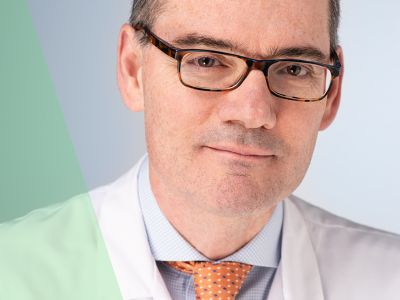
The surgical operation is not about removing the patient’s cancer, which is much too far advanced at this stage, but taking a piece – from a metastasis or organ – that can be used to develop a personalised treatment. Explanations from Prof. Nicolas Demartines, head of the Visceral Surgery Department, who operates, with his team, on the patients we are tracking here as part of an in-depth study.
There are several aspects. First, we either remove a single metastasis to get a sample of the tissue, or we remove the whole organ, but then it has to be done oncologically. That means we also have to remove an additional area of tissue (as a safety margin) and the blood vessels have to be checked when we’re doing the resection. Once the surgical sample has been removed, the rest of the process has to be carried out under sterile conditions, as the cells will later be re-injected into the patient’s body.
It’s essential, for ethical, diagnostic and forensic reasons, that the pathologists are the first to see the sample.
As soon as it’s extracted, the sample is passed to the pathologists under sterile conditions. They then carry out a complete diagnosis, analysing the surgical margin, venous infiltration and the degree of cell differentiation. If it’s a whole organ, the pathologists determine the number of ganglions. It’s only once the analysis has been done that the tissues used to culture the lymphocytes can be taken. There are seven of us in the department who’ve been trained in the clinical trial protocol. The three main elements that differ from a "standard" surgery are the sterility of the tissue after it has been removed, the fact that it has to be analysed by the pathologists and the speed of the process.
Getting these samples is a real race against time, because the lymphocytes have to be alive to culture them.
We have a maximum of 20 to 30 minutes between the surgery and getting the lymphocytes to the laboratory.
But the less time it takes, the better.
No operation is completely benign and some operations take longer than others. In patients with a metastatic melanoma, they are generally shorter operations, which take between 30 minutes and an hour. We remove the affected ganglion or metastasis and close up. For other tumours, it depends on the location of the tumour being removed but the operation can take between two and five hours.
It’s impossible to judge the quality of the tissue before it’s removed. What matters is ease of access. For example, it’s a lot easier to remove a metastasis from the liver than the back of the heart. A second criterion is volume. Prof. Coukos and his team need a minimum of 3 cm3 to culture the cells.

The capital of the canton of Vaud is an oncological research centre which is today recognised throughout Europe. Work on cellular immunotherapy is advancing rapidly and offers a glimpse of a historic breakthrough. This is the story of the team's work, through the eyes of George Coukos.

Whilst approximately 100 research protocols against cancer are currently open at CHUV, all coordinated within the Experimental Therapies Centre, Lana Kandalaft walks us through the challenges of setting up a clinical trial: the intricate path from the laboratory to the patient's bedside.